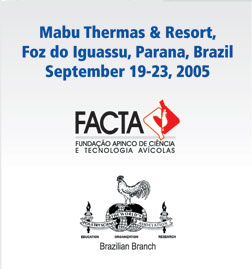Contributed Papers: Oral Presentations
Diagnosis and Epidemiology |
DIGITAL
IMAGE ANALYSIS IN THE DIAGNOSIS OF CHICKEN COCCIDIOSIS
C.A.B. Castañón1,2,
J.S. Fraga1, S. Fernandez1, L.F. Costa2 & A. Gruber1,*
1Faculty of Veterinary Medicine and Zootechny, 2Physics
Institute of São Carlos,
University of São Paulo, Brazil
*argruber@usp.br
Coccidiosis
of the domestic fowl is an enteric disease caused
by seven distinct species of the genus Eimeria. Species
discrimination is classically performed using morphological/pathological
parameters like oocyst size and shape, aspect and
location of the intestinal lesions, etc. However,
accuracy of species assignment by visual inspection
is severely restricted by the slight differences and
overlap of characteristics among the different species.
This work aimed at developing a non-subjective process
for the morphological oocyst identification and classification
through computational analysis of microscope digital
images. Our methodology involves three steps: (i)
image acquisition and preprocessing, (ii) image characterization,
and (iii) image classification. Initially, digital
oocyst images were obtained from pure strains of each
Eimeria species, using a 4-megapixel CCD camera. Each
image was preprocessed to define the parametric contour
of the oocyst wall. In addition, the images were submitted
to an automated feature extraction and classification
system, using shape and textural characteristics (oocyst
length and width, perimeter, area, curvature, texture
and symmetry), and comprising a set of 13 distinct
features [1]. For species discrimination, we used
the multivariate normal density as the discriminative
function for the multidimensional Bayesian learning
classifier [1]. A total of 2,177 oocyst micrographs
of the seven species were captured and 30% of the
images were used as a training set for the generation
of the classification model. The rest of the images,
taking 100 randomly generated groups, were submitted
to two iterations for Bayesian learning. The rate
of correct species assignment varied from 64.9% (E.
necatrix) to 97.7% (E. brunetti), with and overall
rate of 86.8%. A standalone program was implemented
in C++ programming language and installed on a web
server. Thus, a remote user can upload an image and
obtain a real-time electronic diagnosis of the Eimeria
species through the internet. The approach proposed
here may represent an auxiliary tool for the differential
diagnosis of chicken coccidiosis, with the advantage
of not requiring biological sample transportation
between the poultry farm and the reference laboratory.
References
[1] Luciano Costa and Roberto Cesar., Shape Analysis
and Classification, Theory and Practice, CRC Press,
Boca Raton (2001).
Financial support: CAPES, CNPq and FAPESP
